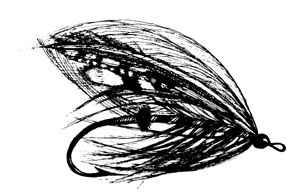


TYING WITH A PENCIL
by Dick Jones
Eugene, Oregon
Without a doubt, the most common complaint of salmon-fly tiers is that they are not able to tie as much as they would like. It takes a good tier from two to ten hours to do one full-dress salmon fly. If you have to work for a living, at least part of the time, plus sleep a little, how can you improve your tying skills? How does the average tier become a super tier overnight? I have a theory and it goes something like this.
Salmon-fly dressing can be broken down into two major areas: the technical and the aesthetic. The technical side involves using the correct materials and attaching them to the hook. This is the "how-to" information gotten from instruction books and classes. These points can be learned in a short time and, with care, can be well executed. The aesthetic side consists of the choice of hook and the composition of the fly, including: proportions, balance, shape, and fullness--the beauty and grace of the fly. This part has the longest learning curve and is the hardest to master for most people.
Eric Taverner, in The Lonsdale Library of Salmon Fishing, said: "I advise the beginner in fly dressing to follow the Greek method and buy or get the loan of some flies dressed by a master of the art, study them intently and allow an impression of their proportions to be formed in his mind, until the instinct is created, whereby he will know exactly the point at which every part of the fly ought to begin and finish." This is a good starting point. Clear photographs can serve as well.
Now here is where you save lots of time--sketch those flies of the "masters" to better understand what you are trying to achieve. Set some specific goals, like getting more of the underwing to show, or getting a fuller wing that is square at the tips, or move the throat a bit forward. Try extending the sides farther back and make sure that the shape of the hook goes with the overall shape and style of the fly. You decide what you want.
I know quite a few of you have already closed your minds and said "Is he crazy? I can't draw diddley." Just open up a bit (salmon-fly tiers are stubborn) and try.
Lightly photocopy some hooks. Try drawing them to scale on graph paper. Even if you think you can't draw, try anyway. It awakens your senses to shape and proportion. You start to notice the subtle differences between hooks, realizing that a hook is not just a hook but part of the shape of the fly.
Next, lightly sketch the outline of a fly around one of these hooks, balancing the various parts (notice that you will not be following the sequence you would in tying). Lightly sketch in parts that will later be covered. As you work the various parts into position for the overall look that you want, make note of what you need to do differently in your application of the materials the next time you tie the fly. Don't be afraid to use the eraser. When you get the sketch the way you want it to look, go over it with a fine-point pen or colored pencils.
If you are having trouble drawing feathers, trace some drawings or try the photocopy machine on a real fly, then trace it. For tinsel, do the outline and then shade some spots. Remember to leave some blank areas to represent shine.
Let's take a look at the advantage we have by sketching.
Time: The first flies you sketch may take twenty to thirty minutes. Soon you should be able to knock one off in ten minutes. Not bad when you compare the two to ten hour time needed for tying a fly.
Develop awareness: Sketching makes you aware of the little differences between a good fly and a great fly. This awareness helps you critique your flies. Aim toward specific accomplishments.
Save materials: When sketching, draw in only the best materials, especially the rare ones. It doesn't deplete the supply.
Increase productivity: Sketching helps you to keep a record of what you are trying to do and allows you to focus on specific points. You should soon notice marked improvement in your tying.
Voila! This could be all you need for that breakthrough to master rank. (As a follow up, I've been considering an article on Tying Flies through Visualization or perhaps Critiquing Flies Using Tae Kwon Do.) Give sketching a try.